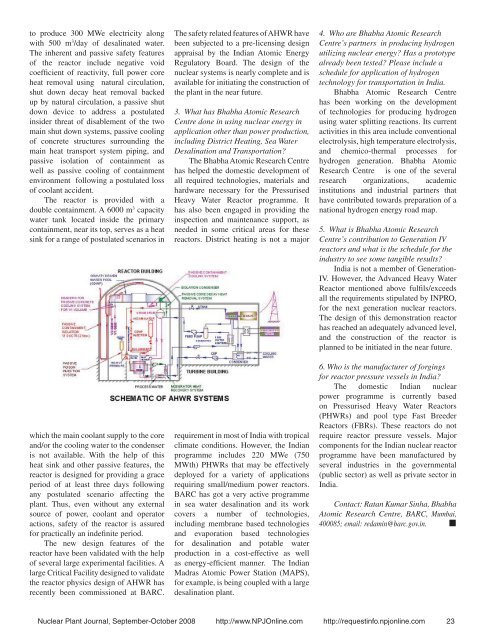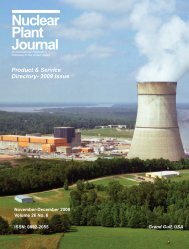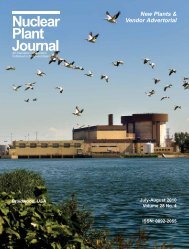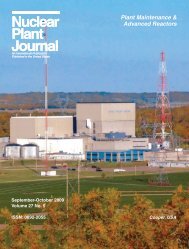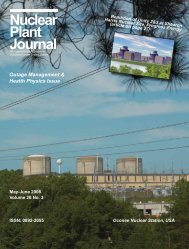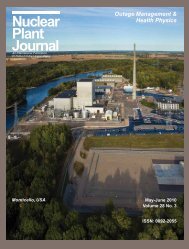Nuclear Plant Journal - Digital Versions
Nuclear Plant Journal - Digital Versions
Nuclear Plant Journal - Digital Versions
Create successful ePaper yourself
Turn your PDF publications into a flip-book with our unique Google optimized e-Paper software.
to produce 300 MWe electricity along<br />
with 500 m 3 /day of desalinated water.<br />
The inherent and passive safety features<br />
of the reactor include negative void<br />
coefficient of reactivity, full power core<br />
heat removal using natural circulation,<br />
shut down decay heat removal backed<br />
up by natural circulation, a passive shut<br />
down device to address a postulated<br />
insider threat of disablement of the two<br />
main shut down systems, passive cooling<br />
of concrete structures surrounding the<br />
main heat transport system piping, and<br />
passive isolation of containment as<br />
well as passive cooling of containment<br />
environment following a postulated loss<br />
of coolant accident.<br />
The reactor is provided with a<br />
double containment. A 6000 m 3 capacity<br />
water tank located inside the primary<br />
containment, near its top, serves as a heat<br />
sink for a range of postulated scenarios in<br />
which the main coolant supply to the core<br />
and/or the cooling water to the condenser<br />
is not available. With the help of this<br />
heat sink and other passive features, the<br />
reactor is designed for providing a grace<br />
period of at least three days following<br />
any postulated scenario affecting the<br />
plant. Thus, even without any external<br />
source of power, coolant and operator<br />
actions, safety of the reactor is assured<br />
for practically an indefinite period.<br />
The new design features of the<br />
reactor have been validated with the help<br />
of several large experimental facilities. A<br />
large Critical Facility designed to validate<br />
the reactor physics design of AHWR has<br />
recently been commissioned at BARC.<br />
The safety related features of AHWR have<br />
been subjected to a pre-licensing design<br />
appraisal by the Indian Atomic Energy<br />
Regulatory Board. The design of the<br />
nuclear systems is nearly complete and is<br />
available for initiating the construction of<br />
the plant in the near future.<br />
3. What has Bhabha Atomic Research<br />
Centre done in using nuclear energy in<br />
application other than power production,<br />
including District Heating, Sea Water<br />
Desalination and Transportation<br />
The Bhabha Atomic Research Centre<br />
has helped the domestic development of<br />
all required technologies, materials and<br />
hardware necessary for the Pressurised<br />
Heavy Water Reactor programme. It<br />
has also been engaged in providing the<br />
inspection and maintenance support, as<br />
needed in some critical areas for these<br />
reactors. District heating is not a major<br />
requirement in most of India with tropical<br />
climate conditions. However, the Indian<br />
programme includes 220 MWe (750<br />
MWth) PHWRs that may be effectively<br />
deployed for a variety of applications<br />
requiring small/medium power reactors.<br />
BARC has got a very active programme<br />
in sea water desalination and its work<br />
covers a number of technologies,<br />
including membrane based technologies<br />
and evaporation based technologies<br />
for desalination and potable water<br />
production in a cost-effective as well<br />
as energy-efficient manner. The Indian<br />
Madras Atomic Power Station (MAPS),<br />
for example, is being coupled with a large<br />
desalination plant.<br />
4. Who are Bhabha Atomic Research<br />
Centre’s partners in producing hydrogen<br />
utilizing nuclear energy Has a prototype<br />
already been tested Please include a<br />
schedule for application of hydrogen<br />
technology for transportation in India.<br />
Bhabha Atomic Research Centre<br />
has been working on the development<br />
of technologies for producing hydrogen<br />
using water splitting reactions. Its current<br />
activities in this area include conventional<br />
electrolysis, high temperature electrolysis,<br />
and chemico-thermal processes for<br />
hydrogen generation. Bhabha Atomic<br />
Research Centre is one of the several<br />
research organizations, academic<br />
institutions and industrial partners that<br />
have contributed towards preparation of a<br />
national hydrogen energy road map.<br />
5. What is Bhabha Atomic Research<br />
Centre’s contribution to Generation IV<br />
reactors and what is the schedule for the<br />
industry to see some tangible results<br />
India is not a member of Generation-<br />
IV. However, the Advanced Heavy Water<br />
Reactor mentioned above fulfils/exceeds<br />
all the requirements stipulated by INPRO,<br />
for the next generation nuclear reactors.<br />
The design of this demonstration reactor<br />
has reached an adequately advanced level,<br />
and the construction of the reactor is<br />
planned to be initiated in the near future.<br />
6. Who is the manufacturer of forgings<br />
for reactor pressure vessels in India<br />
The domestic Indian nuclear<br />
power programme is currently based<br />
on Pressurised Heavy Water Reactors<br />
(PHWRs) and pool type Fast Breeder<br />
Reactors (FBRs). These reactors do not<br />
require reactor pressure vessels. Major<br />
components for the Indian nuclear reactor<br />
programme have been manufactured by<br />
several industries in the governmental<br />
(public sector) as well as private sector in<br />
India.<br />
Contact: Ratan Kumar Sinha, Bhabha<br />
Atomic Research Centre, BARC, Mumbai,<br />
400085; email: redamin@barc.gov.in. <br />
<strong>Nuclear</strong> <strong>Plant</strong> <strong>Journal</strong>, September-October 2008 http://www.NPJOnline.com http://requestinfo.npjonline.com 23


